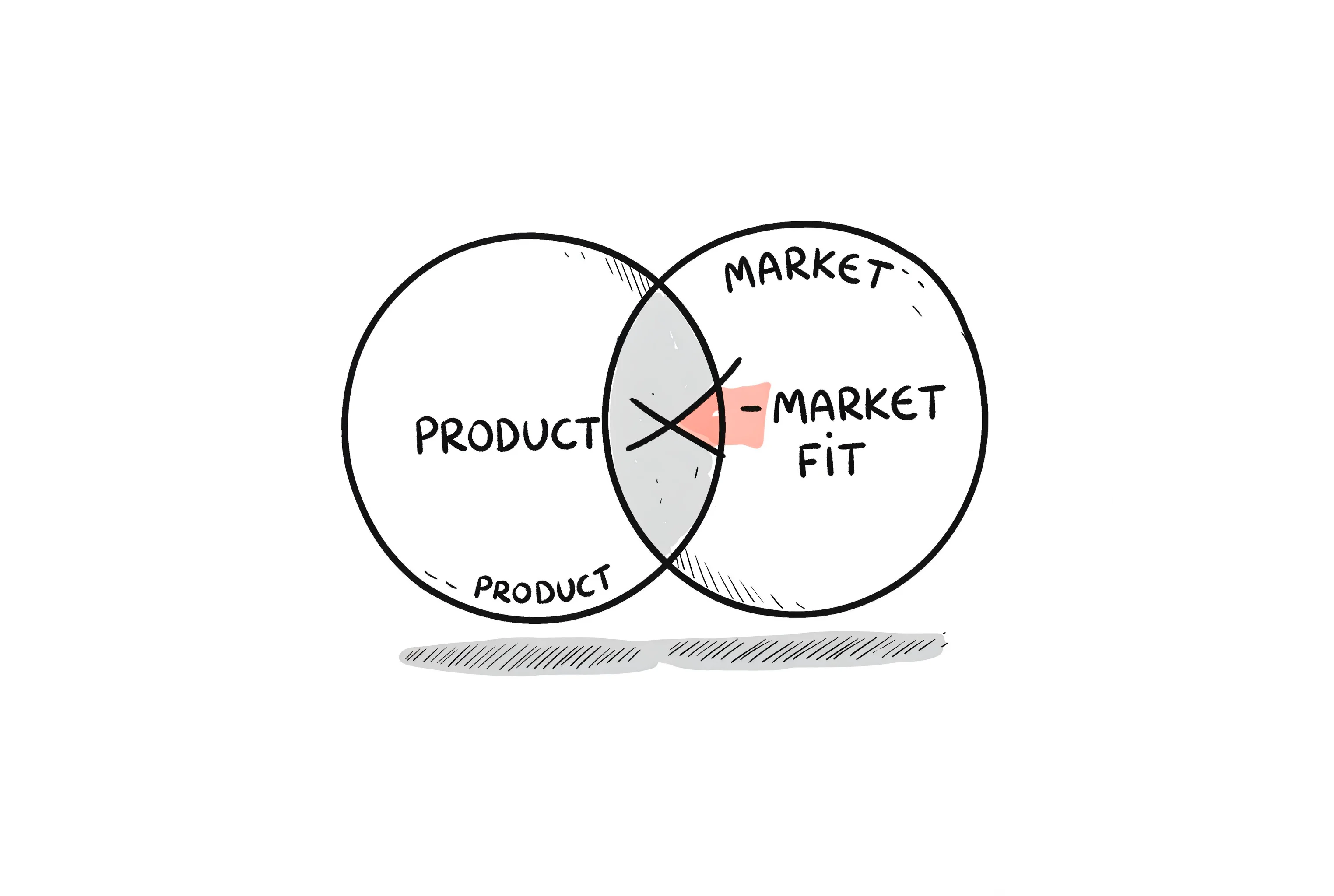
Simon Jenner
Thursday 30 January 2025

What is product-market fit? Learn how startups can validate, measure, and achieve PMF with data-driven strategies for sustainable growth and scalability.
Posted in:
Startups
Product-market fit (PMF) is a critical milestone for any startup. It determines whether a product truly meets market demand, drives organic growth, and achieves long-term success.
Marc Andreessen, who coined the term, describes it as:
"The customers are buying the product just as fast as you can make it—or usage is growing just as fast as you can add more servers. Money from customers is piling up in your company checking account."
Without PMF, startups risk high churn rates, inefficient marketing spend, and eventual failure. In fact, 42% of startups fail because they do not address a real market need.
This guide will explore what PMF is, why it matters, how to measure it, and proven strategies to achieve it.
Why Product-Market Fit Matters
Achieving PMF is essential for long-term startup success. Startups that successfully reach PMF experience:
Higher retention and lower churn: Customers return and continue using the product.
Stronger investor confidence: A validated product attracts funding.
Lower customer acquisition costs (CAC): A well-fitted product spreads through referrals rather than heavy advertising.
Faster revenue growth: Businesses scale naturally when demand exceeds supply.
According to Sequoia Capital, PMF is about finding customers who "have their hair on fire"—meaning they desperately need a solution.
How to Measure Product-Market Fit
There is no single formula for PMF, but these key indicators help determine whether a product has reached it.
1. The 40 Percent Rule (Sean Ellis Test)
Sean Ellis, the marketer behind Dropbox’s growth, introduced a simple test:
Ask customers: "How would you feel if you could no longer use this product?"
If 40% or more say "very disappointed," the product has likely reached PMF.
2. Customer Retention and Engagement
Retention is a major sign of PMF. A well-fitted product keeps users coming back.
A DAU/MAU ratio above 20% indicates strong engagement.
SaaS businesses with a 6-month retention rate above 30% can be considered successful.
3. Organic Growth and Referrals
If 40% or more of new users come from referrals, it indicates strong PMF.
Products with network effects grow exponentially once PMF is reached.
4. Conversion Rates and Willingness to Pay
A high trial-to-paid conversion rate (over 30%) suggests that users find real value in the product.
Customers willing to pay without requiring heavy discounts is a strong PMF indicator.
5. Net Promoter Score (NPS)
A Net Promoter Score above 50 suggests that customers are enthusiastic enough to recommend the product.
Signs You Have Not Reached Product-Market Fit
If PMF is weak, startups will struggle with:
High churn rates: If users drop off quickly, the product does not provide lasting value.
Heavy reliance on paid advertising: A product with PMF grows organically through word-of-mouth.
Customer confusion: If people frequently misunderstand the product, messaging and positioning may be unclear.
Long sales cycles: Products with strong PMF typically convert customers quickly.
How to Achieve Product-Market Fit: A Step-by-Step Framework
Step 1: Identify Your Target Customer
A startup must deeply understand its ideal customer profile. This includes:
Demographics: Who are they?
Pain points: What problem do they need solved?
Alternative solutions: What are they currently using?
Step 2: Validate a Real Pain Point
Investors often look for customers who desperately need a solution now.
Conduct problem interviews: Ask, “What is your biggest frustration with X?”
Run landing page tests to gauge demand before building.
Offer pre-sales or crowdfunding to measure willingness to pay.
Step 3: Build a Minimum Viable Product (MVP)
An MVP should be the simplest possible version of the product that provides value.
Dropbox validated demand with an explainer video before building a real product.
Airbnb founders manually recruited their first hosts before automating the platform.
Ps: you can get started with your MVP today either by building it yourself with our Build an MVP Today Guide or by asking us to do everything for you and have it deployed fast.
Step 4: Test, Iterate, and Improve
Use heatmaps, session recordings, and surveys to refine the product.
Interview early adopters and ask why they use the product.
Remove features that users do not find valuable.
Step 5: Scale Only After Achieving Retention
A common mistake is scaling too early. Instead, focus on:
Improving onboarding to increase activation rates.
Optimizing the pricing model based on customer willingness to pay.
Strengthening customer support to reduce churn.
Real-World Examples of Product-Market Fit in Action
Slack
Slack was initially built as a communication tool for gaming teams. When the founders noticed business teams using it instead, they pivoted.
Within 24 hours of launch, Slack had 8,000 signups.
Airbnb
Airbnb founders manually recruited hosts and took professional photos of apartments to prove demand before automating.
Demand grew so quickly that they struggled to keep up with bookings.
In a Nutshell
Product-market fit is the foundation of a successful startup. Achieving it requires deep customer understanding, continuous iteration, and strong retention before scaling.
For startups still searching for PMF, the best strategy is to stay lean, listen to users, and pivot when necessary.
Need Help Achieving Product-Market Fit?
Finding product-market fit is one of the hardest yet most crucial steps for any startup. Without it, even the best ideas struggle to gain traction. At Million Labs, we specialize in extensive market testing, validation, and iteration to ensure your product has a real market demand before you scale.
We don’t just build products—we test, refine, and validate your idea to make sure there’s a proven market fit worth exploring. Let’s make sure your startup is positioned for success.
👉 Check more recommended resources to Start, Launch and Grow your SaaS:
Building Your No-Code MVP: A Complete Guide to Launch Within the Next 60 Days
Mastering App Scoping: The Only Guide You'll Need as A First Time Founder
Ready to launch your startup idea with an MVP?
Download our step by step guide for non-technical founders to create a startup Minimum Viable Product (MVP)
Get the eBook

